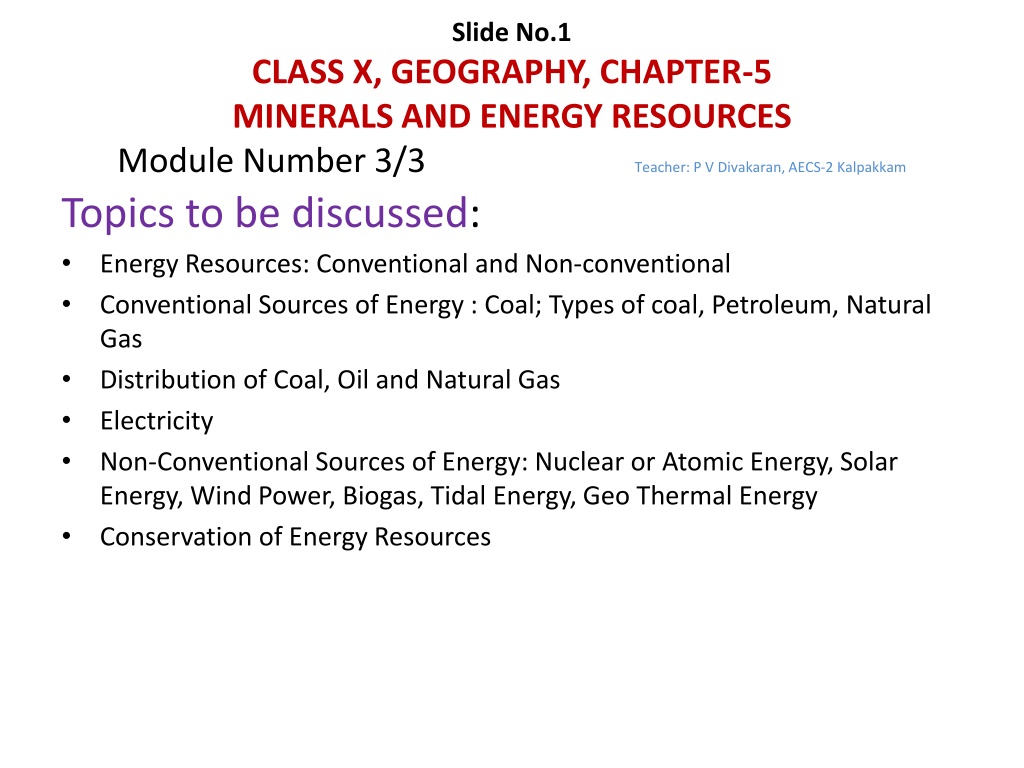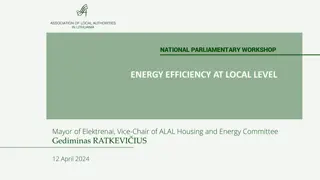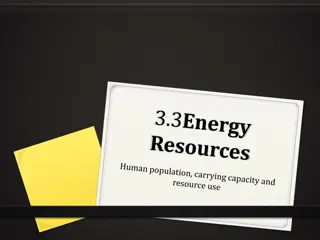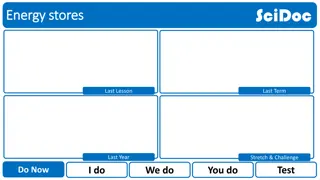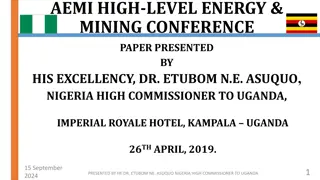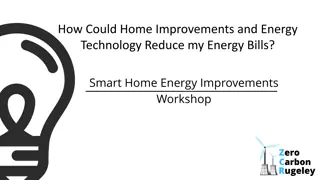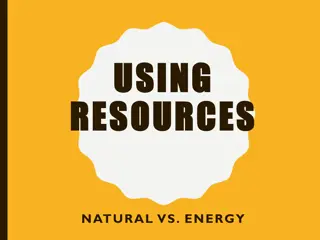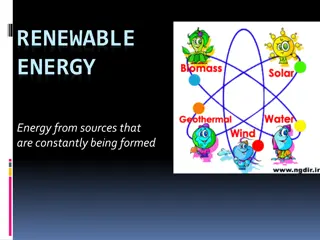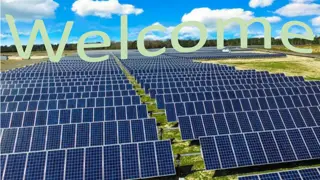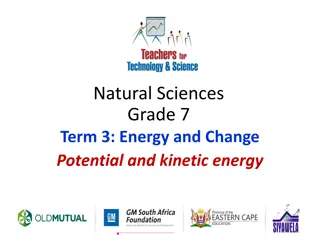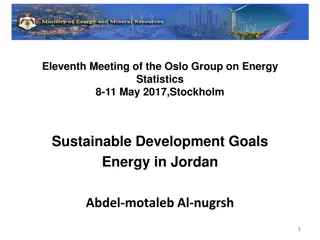Energy Resources: Conventional and Non-Conventional Sources Discussed
This presentation covers a detailed discussion on different energy resources including conventional sources like coal, petroleum, and natural gas, as well as non-conventional sources such as solar energy, wind power, and nuclear energy. It explores the distribution, types, and major fields of coal, petroleum, and natural gas, highlighting their significance in power generation and industrial applications. Additionally, it emphasizes the importance of conserving energy resources for sustainable development.
Download Presentation

Please find below an Image/Link to download the presentation.
The content on the website is provided AS IS for your information and personal use only. It may not be sold, licensed, or shared on other websites without obtaining consent from the author. Download presentation by click this link. If you encounter any issues during the download, it is possible that the publisher has removed the file from their server.
E N D
Presentation Transcript
Slide No.1 CLASS X, GEOGRAPHY, CHAPTER-5 MINERALS AND ENERGY RESOURCES Module Number 3/3 Teacher: P V Divakaran, AECS-2 Kalpakkam Topics to be discussed: Energy Resources: Conventional and Non-conventional Conventional Sources of Energy : Coal; Types of coal, Petroleum, Natural Gas Distribution of Coal, Oil and Natural Gas Electricity Non-Conventional Sources of Energy: Nuclear or Atomic Energy, Solar Energy, Wind Power, Biogas, Tidal Energy, Geo Thermal Energy Conservation of Energy Resources
Slide No.2 Energy Resources Resources which are used as power to run industries are called energy resources. Example: Fuel minerals like coal, petroleum, natural gas, uranium and electricity. Energy resources can be classified into conventional and non-conventional sources. Conventional: It includes firewood, cattle dung cake, coal, petroleum, natural gas and electricity. Non-conventional: It includes solar, wind, tidal, geothermal, biogas and atomic energy. They are inexhaustible and renewable. Coal: Coal is a fossil fuel It is used for power generation in thermal power plants. It is bulky. So many coal based industries are located near coalfields. Coal is formed due the compression of plant material over millions of years.
Slide No.3 Types of Coal Peat: It has a low carbon and high moisture contents and low heating capacity. Lignite: It is a low grade brown coal, which is soft with high moisture content. Major lignite reserves are in Neyveli in Tamil Nadu and are used for generation of electricity. Bituminous: o It is has been buried deep and subjected to increased temperatures o It is the most popular coal in commercial use. o High grade bituminous coal is used for smelting iron in blast furnaces Anthracite: It is the highest quality hard coal. Major Coalfields: Damodar valley (West Bengal-Jharkhand) The Godavari, Mahanadi, Son, and Wardha valley, Jharia, Raniganj, Bokaro, Karanpura, Chandrapura,Giridih,Deogargh,Korba, Singrauli, Talcher are important coalfields.
Slide No.4 Petroleum Petroleum is also known as mineral oil or liquid gold. It is the second energy source in India after coal. It provides fuel for heating and lighting It provides lubricants for machinery It provides raw materials for a number of manufacturing industries Petroleum refineries act as a nodal industry for synthetic textile, fertiliser industries and chemical industries. In India most of the petroleum occurrences are associated with anticlines and fault traps in the rock formations of the tertiary age. 63 % of India s petroleum production is from Mumbai High 18 % from Gujarat and 16 % from Assam Major oilfields of India are : Mumbai High Ankeleshwar Digboi, Naharkatiya Moran-Hugrijan - Assam - Maharastra - Gujarat - Assam - Assam
Slide No.5 Natural Gas It is a clean energy resource It is environment friendly fuel because of its low carbon dioxide emissions It is also used as a raw material in petrochemical industry Use of CNG for vehicles is gaining wide popularity in the country. Reserves of natural gas: o Krishna- Godavari Basin o Mumbai High o Gulf of Cambay o Andaman and Nicobar islands Major Gas Pipeline: o Hazira-Vijaipur Jagdishpur (HVJ) pipelines cross country gas pipeline links Mumbai High and Bassien with the fertilizer, power and industrial complexes in western and northern India.
Slide No.6 Distribution of coal, oil and Natural Gas
Slide No.7 Electricity In todays life electricity is used for many purposes. Its percapita consumption is considered as an index of development. Electricity is generated mainly in two ways: 1. by running water which drives hydro turbines to generate hydro electricity Example: Bhakra Nangal, Damodar Valley Corporation, the Kopili Hydel Project etc. 2. by burning fuels such as coal, petroleum and natural gas to drive turbines to produce thermal power. Example: Singrauli, Namrup, Ramagundam, Talcher , Neyveli, etc.
Slide No.8 Non-Conventional Sources of Energy Why should we promote the use of renewable or non conventional source of energy? o Shortages of fossil fuels have raised uncertainties about the security of energy supply in future. o Rising prices of oil and gas has raised uncertainty. o Increasing use of fossil fuels also causes serious environmental problems. Nuclear or Atomic Energy It is obtained by altering the structure of atoms. When alteration is made, much energy is released in the form of heat and this heat is used to generate electric power. Uranium and Thorium are used as fuel which are available in Jharkhand and the Aravalli ranges of Rajasthan. Monazite sands of Kerala is also rich in Thorium. Major Nuclear Power Stations of India are: Kalpakkam, Kaiga, Kakrapara, Kudamkulam, Rawat Bhata, Narora & Tarapore
Slide No.9 Nuclear and Thermal Power Plants of India
Slide No.10 Solar Energy By using photovoltaic technology solar energy is converted into electricity India is a tropical country. There is enormous possibilities of tapping solar energy It has minimised the dependence of rural households on firewood and dung cakes It contributes to environmental conservation and adequate supply of manure in agriculture India s largest solar power plant is located in Madhapur near Bhuj in Gujarat.
Slide No.11 Wind Power Wind energy is utilised to turn huge windmills to generate electricity. India has great potential of wind power. The largest wind farm cluster is in Tamil Nadu from Nagarcoil to Madurai. Other important wind farms are in Andhra Pradesh, Karnataka, Gujarat, Kerala, Maharashtra and Lakshadweep. Nagarcoil and Jaisalmer are well known for effective use of wind energy.
Slide No.12 Biogas Biogas is produced by the decomposition of organic matters like shrubs, farm waste, animal and human waste. Biogas has higher thermal efficiency in comparison to kerosene or charcoal. It is mainly used for domestic consumption in rural areas. The plants using cattle dung are known as Gobar gas plants . It provides twin benefits to the farmer in the form of energy and manure. It also prevents the loss of trees due to the burning of fuel wood.
Slide No.13 Tidal Energy What is tidal energy? Tidal energy is the energy generated by the movement of oceanic tides. Do you know how tidal energy is generated? During high tide when water flows into the inlet and gets trapped then the gate is closed. After the tide falls outside, the water retained by the floodgate flows back to the sea through a pipe that is fitted with a power-generating turbine. Thus electricity is generated. Tidal Energy Generating Centers: o Gulf of Khambhat in Gujarat o Gulf of Kuchchh in Gujarat o Gangetic delta in Sunderban regions of West Bengal
Slide No.14 Geo Thermal Energy It refers to the heat and electricity produced by using the heat from the interior of the Earth. How Geo Thermal Energy is generated? The Earth grows progressively hotter with increasing depth. Groundwater in such areas absorbs heat from the rocks and becomes hot. When it rises to the earth s surface in the form of hot spring, it turns into steam. This steam is used to drive turbines and thus electricity is generated. Areas of Geo Thermal Energy generation in India: 1. Parvati valley near Manikarn in Himachal Pradesh 2. Puga Valley, Ladakh
Slide No.15 Conservation of Energy Resources energy saved is energy produced Why should we conserve energy resource? o Consumption of energy has been steadily rising all over the country. o Every sector of the national economy agriculture, industry, transport, commercial and domestic needs energy. o In this context, there is an urgent need to develop a sustainable path of energy development. o We should prefer to use renewable sources energy. o We have to use our limited energy resources judiciously. For example: o We have to use public transport systems instead of individual vehicles. o We should switch off electricity when not in use. o We should use power-saving devices. o We should prefer to use non-conventional sources of energy.
Slide No.16 Recapitulation Why should we need to conserve energy resources? Bing out the difference between thermal power and hydel power projects. What is solar energy? Explain its importance. How is biogas produced? Why is it called Gobar gas plant in rural areas? Distinguish between conventional source and non conventional source of energy. Give examples for multipurpose projects of India. Name the two countries which import iron ore from India. Distinguish between Bio Gas and Natural Gas. In which regions does petroleum occur in India? How is tidal energy produced? Name some Nuclear Power Stations of India.
